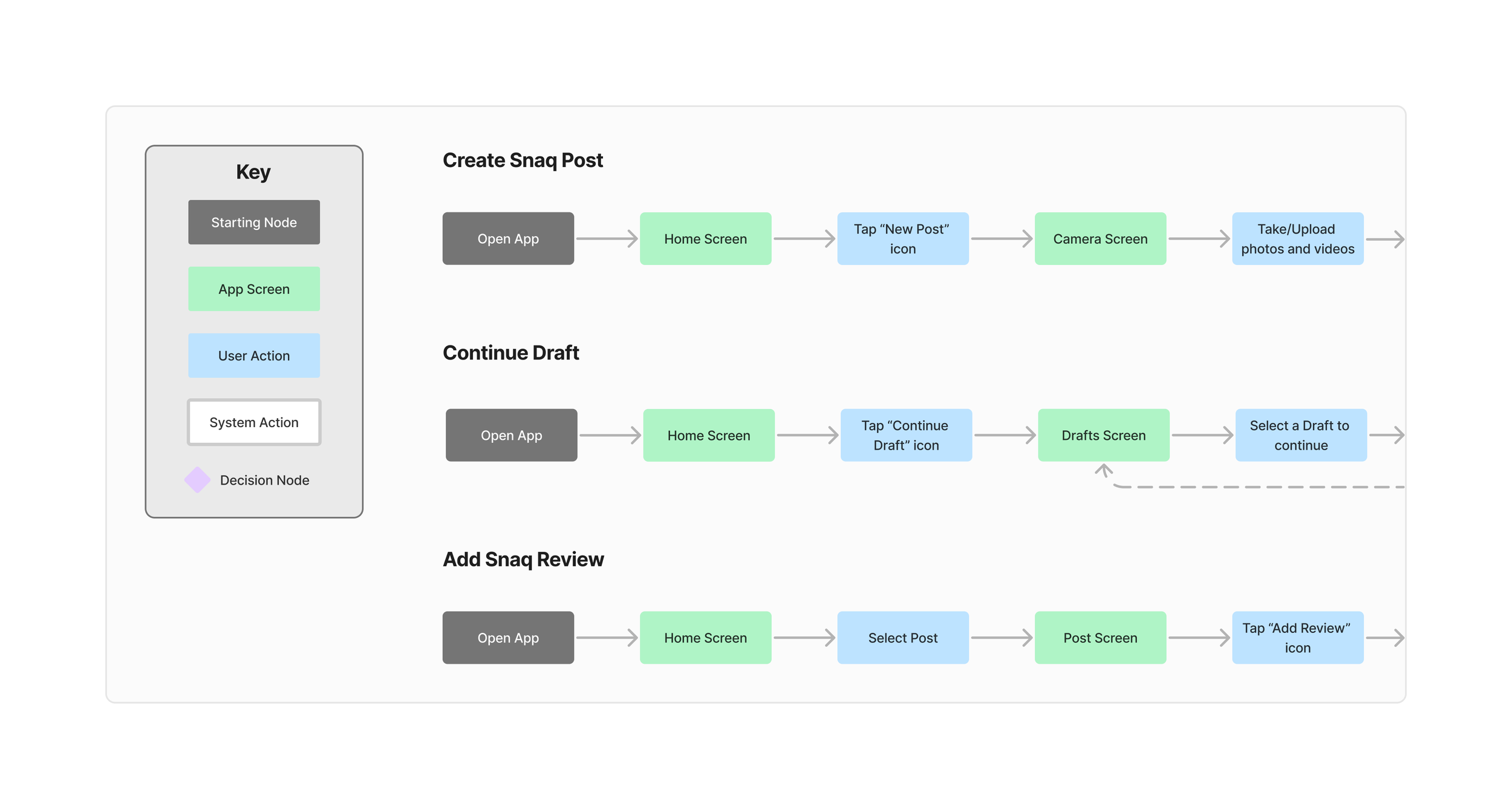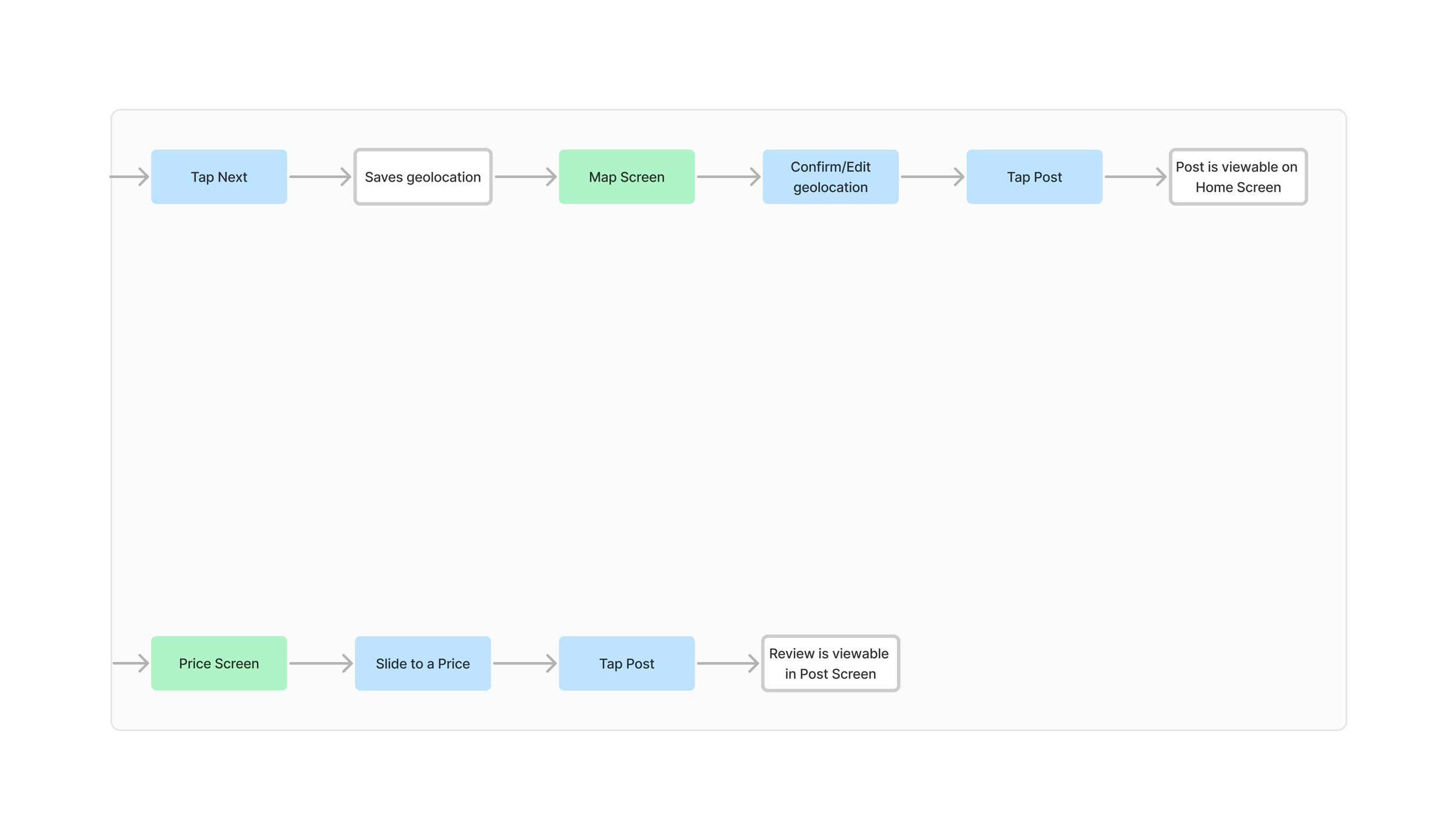
Snaqies - Food Logging App
Project Overview
Can’t remember which foods or restaurants you’ve tried? Try Snaqies! This app makes capturing your food adventures easy and unfiltered. Snap a photo, tag the location, add a review—and keep all your dining memories in one place!
PROBLEM STATEMENT
Food enthusiasts exploring new restaurants need a simple, organized way to remember the places they've visited and dishes they've tried.
ROLES
UX Designer & Developer
Agile Scrum Leader
RESPONSIBILITIES
Wireframes, prototype, user interviews, usability tests, affinity diagrams, code
PROJECT DURATION
September 2023 - Present
SOLUTION
Create an MVP while building new skills in a collaborative team environment.
Latest Prototype
Click to interact with the prototype.
Process
1. Identify Features
2. User Flow
3. Wireframe
4. Feedback
5. Iterate Design
User Flow



Design Iteration - 1
How it started…
Used Figma for the first time
Before being more knowledgeable about wireframes, I plunged straight into designing a high-fidelity app instead of ideating on one feature at a time.
Navigation Types
Menu icon is not intuitive and requires users to make multiple taps instead of one, however, it saves a significant amount of screen space.
Tab bar is as intuitive as it is contemporary, requiring only one tap and being convenient for users to use their thumbs.
Top-heavy icons take up significant screen space, but paired with text-based buttons this navigation system is the most intuitive.
FINAL: Uses contemporary tab bar, but enhances usability by improving iconography, adding icon labels, and reducing the number of tabs to focus on core MVP features.
Research
TYPE
1-on-1 Interview & Usability Testing
DURATION
November 2023 - December 2023
PARTICIPANTS
6 food enthusiasts, ages 21-27
GOAL
Gain a deeper understanding of our target audience and gather data to inform our design decisions.
1. People default to the most low-effort method of capturing and sharing food-related data.
Almost all participants mentioned that they take photos of their food, which requires minimal time and effort.
Photos are often the only form of documentation created.
Other forms include bookmarking and reviewing establishments.
Many participants upload these photos to social media or share them through messages—both quick options that are soon forgotten.
2. People do high-effort things when there is incentive.
One participant wrote food reviews to achieve Yelp Elite status, which rewards members with free food and exclusive events.
Another participant left a review for a restaurant that offered a free dessert in exchange for a 5-star review on Google Maps.
A different participant used ratings to help remember whether they enjoyed particular boba places or not.
Design Iteration - 2
Tagging Food Names
Iteration 1
Users enter food names one by one, select a food, and then select all photos containing that food.
The tagging system operates in O(n²) time, requiring users to take exponential time to search through every photo for every food.
A previous feature that allowed filtering images by food names was removed due to the high-effort required by the current method.
Iteration 2
Users select a photo and tap a specific area to create a pop-up tag.
Users only need to tag a photo once, as the location of the tag intuitively indicates how the food will appear in other photos, similar to Instagram.
This new tagging system reduces time complexity to O(n), meaning time is only proportional to the number of food names.
Viewing Post
Iteration 1
Users were unsure whether our app was for intended for private or social use, as the review area resembled a comment section.
Using a slider for photos can become tedious as the number of photos increases.
Iteration 2
UI no longer includes profile pictures.
Version 2.0 explored using a scrolling method for displaying photos, but this is still tedious.
Version 2.1 adopts a grid layout, placing less emphasis on reviews. The rationale is that users would typically want to view photos before reading reviews.
-
Having progressed in creating a low-effort user experience, the next step is to establish incentives for high-effort activities, such as uploading photos and writing reviews, which cannot easily simplify to become low-effort.
Efforts to develop the app have been slow but steady, and can be further improved by focusing on core MVP features.
-
This project was a valuable learning opportunity that allowed me to delve into mobile app design and development. I became familiar with various new tools, including Figma, FigJam, React Native, Expo Go, Google Maps API, and GitHub Projects.
Having taken on diverse roles in this project, I realize the importance of setting clearer expectations for myself within the team and accurately assessing my contributions to support the agile team flow and allow other team members to take on tasks effectively.
This project also emphasized my need to practice with research and data. I struggled to maintain a clear focus on a specific goal while trying to conduct both user interviews and usability testing simultaneously, which resulted in an overwhelming amount of data that was difficult to organize and analyze.

